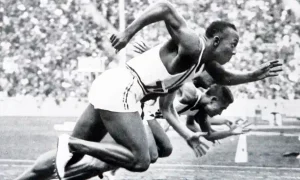Jesse Owens Honored With Commemorative Plaque At Michigan’s Ferry Field

A new plaque honoring former Ohio State runner and legendary American Olympian Jesse Owens will be unveiled at the University of Michigan on Thursday, commemorating his record-breaking performance at the 1935 Big Ten Outdoor Track and Field Championships held at Michigan’s Ferry Field in Ann Arbor.
The plaque — which is being organized by World Athletics, formerly known as the International Amateur Foundation — honors the site where Owens broke or tied four world records on May 25, 1935. In a span of just 45 minutes, the 21-year-old sophomore Owens tied the world record in the 100-yard dash (9.4 seconds), and set three world records in long jump (8.13 meters), 220 yards (20.3 seconds) and 220-yard low hurdle (22.6).
This performance, later dubbed “Day of Days” catapulted Owens to the national spotlight and helped him an invitation to the 1936 Berlin Summer Olympics, where — amidst heavy racial discrimination from Nazi Germany — he won four medals in the 100m, 200m, 4x100m relay and long jump.
The new plaque will be unveiled one day before Michigan hosts the Big Ten Track and Field Championships at U-M Track & Field Stadium, the first time the university has hosted the event since 1988. Marlene Dortch, the granddaughter of Owens, along with representatives of both the Ohio State and Michigan track & field teams will reveal the plaque, which will replace one given by World Athletics in 2018.
“What Jesse Owens, an icon not only of American sport but also American ideals, accomplished here with four world records in the span of 45 minutes in May of 1935 will never again be replicated,” Michigan athletic director Warde Manuel previously said in a 2018 statement. “We are proud to have such hallowed grounds open to the public as part of our campus, where future generations can retrace in awe the steps of an American hero.”
Owens, whose lone Olympic appearance was in the Berlin Games, won a record eight individual NCAA Championships at Ohio State, four each in 1935 and 1936. He was given the United States Medal of Freedom from President Gerald Ford in 1976 and was inducted into the U.S. Olympic Hall of Fame in 1983 and the Collegiate Athlete Hall of Fame as part of their inaugural classes.